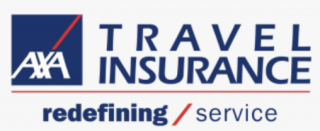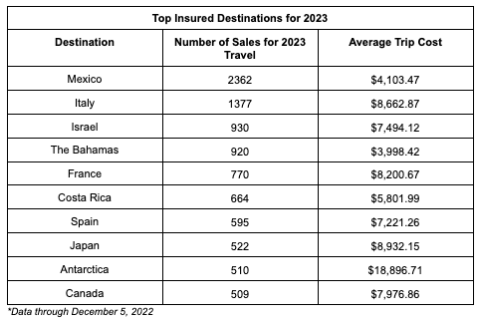AD
Travel Insurance Policies and Quotes for 2023
Compare travel insurance quotes and find the best policy for you and your family.
with SquareMouth
14 Best Travel Insurance Companies in September 2023
Many or all of the products featured here are from our partners who compensate us. This influences which products we write about and where and how the product appears on a page. However, this does not influence our evaluations. Our opinions are our own. Here is a list of our partners and here's how we make money.
If the past few years have shown us anything, it’s that travelers need to be prepared for the unexpected — from a pandemic to flight troubles to the crowded airport terminals so many of us have encountered.
Whether you’re looking for an international travel insurance plan, emergency medical care or a policy that includes extreme sports, these are the best travel insurance providers to get you covered.
We looked at quotes from various companies for a 10-day trip to Spain in November 2023. The traveler was a 35-year-old woman from Illinois who spent $2,000 total on the trip, including airfare.
On average, the price of each company’s most basic coverage plan was $74.07. The costs displayed below do not include optional add-ons, such as Cancel For Any Reason coverage or pre-existing medical condition coverage.
However, depending on the plan, you may be able to customize at an added cost.
Company | Basic coverage cost | Recommended for … |
|---|---|---|
Allianz Global Assistance | $91. | Economical travelers who want to add on cheap rental car protection. |
Travel Guard by AIG | $75. | Those traveling with pre-existing medical conditions and cruisegoers. |
USI Affinity Travel Insurance Services | $85. | International students, groups and cruisegoers. |
Travel Insured International | $95. | Sports fans and concertgoers with pricey belongings. Plans cover traveling with expensive electronic equipment and high-cost ticketed events. |
World Nomads | $81. | Thrill seekers. Plans automatically cover 200-plus adventurous activities. |
Berkshire Hathaway Travel Protection | $57. | Travelers looking for customizable, comprehensive coverage at a low price. Includes cruises. |
Travelex Insurance Services | $63. | Travelers who want top-notch medical coverage. Top-tier plan includes optional Medical Coverage upgrade with $50,000 in medical expense coverage and $500,000 in medical evacuation coverage on top of what is already included. |
Seven Corners | $75. | Traveling athletes. Seven Corners offers medical-only protection plus options to cover sports and golf equipment rental. |
IMG | $59. | Long-term budget travelers. The most basic package covers trips up to 180 days and offers 100% trip cancellation coverage and 125% trip interruption coverage. |
AXA Assistance USA | $69. | Risk-conscious but economical travelers who want basic protection. |
AAA | $61. | Anyone looking for coverage. You don’t have to be a AAA member to buy a policy. |
Tin Leg | $64. | Those who have a lot of time to compare policies and look for bargains. |
TravelSafe | $89. | U.S. residents shopping for single-trip coverage and those booking with points or miles. |
HTH Insurance | $74. | Travelers searching for group trip coverage, including missionaries and crew. |
Top travelers insurance
Let’s look at our travel insurance recommendations for 2023.

Allianz Global Assistance
What makes Allianz Global Assistance great:
Annual and single-trip plans.
Plans are available for international and domestic trips.
Stand-alone and add-on rental car damage product available.
Why we chose it:
Allianz Global Assistance is a reputable travel insurance company offering plans for over 25 years. Customers can choose from a variety of single and annual policies to fit their needs. On top of comprehensive coverage, some travelers might opt for the more affordable OneTrip Cancellation Plus, which is geared toward domestic travelers looking for trip protections but don’t need post-departure benefits like emergency medical or baggage lost.
For our test trip, Allianz Global Assistance’s basic coverage cost $91, about $17 above average.
Pros:
Multiple types of insurance available.
All plans include access to a 24/7 assistance hotline.
Cons:
More expensive than average.
Rental car protection only available by adding the One Trip Rental Car protector to your plan.

Travel Guard by AIG
What makes Travel Guard by AIG great:
Three comprehensive plans and a Pack N' Go plan for last-minute travelers who don't need cancellation benefits.
Flight protection, car rental, and medical evacuation coverage, as well as annual plans available.
Pre-existing medical conditions exclusion waiver available on all plan levels, as long as it's purchased within 15 days.
Why we chose it:
Travel Guard by AIG offers a variety of plans and coverages to fit travelers’ needs. On top of more standard trip protections like trip cancellation, interruption, baggage and medical coverage, the Cancel For Any Reason upgrade is available on certain Travel Guard plans, which allows you to cancel a trip for any reason and get 50% to 75% of your nonrefundable deposit back as long as the trip is canceled at least two days before the scheduled departure date.
At $75 for our sample trip, the Essential plan was about average.
Pros:
Offers last-minute coverage.
Plan available for business travelers.
Car rental coverage is available as an add-on.
Cons:
Cancel For Any Reason coverage available only for higher-level plans.
Enhancement bundles will up your coverage price.

USI Affinity Travel Insurance Services
What makes USI Affinity Travel Insurance Services great:
Search comprehensive plan types by policy name, insurance needs and traveler type.
Medical and evacuation plans for international travel.
One annual plan with two levels of coverage to choose from.
Why we chose it:
USI's website makes searching for plans based on your specific needs easy. This can be helpful whether you’re specifically looking for a plan offering Cancel For Any Reason coverage, going on a cruise or taking an RV trip. The company also has medical plans designed specifically for students studying abroad, including visitors to the U.S.
Pros:
Can add on a pre-existing medical condition exclusion waiver within 21 days of the date your initial trip deposit for higher-cost plans.
Offers a variety of plans for groups, students and visitors to the U.S.
Cons:
Add-on options like Cancel For Any Reason and pre-existing condition waivers are not available on the lower-level plan.
Trip plan cost was higher than average.

Travel Insured International
What makes Travel Insured International great:
Comprehensive and medical-only plans.
Flight plans include coverage for missed and canceled flights and lost or stolen baggage.
Why we chose it:
Travel Insured International offers several customization options. For instance, pet owners might want to add on kennel coverage, which covers boarding costs if your trip is delayed. Traveling with expensive gear or attending an expensive concert/sporting event? Consider adding on coverage for electronic equipment and ticketed events.
Be sure to check which policies are available in your state. You will need to input your destination, residence, trip dates and the number of travelers to get a quote and see coverages.
Pros:
Annual or single-trip policies are available.
Medical-only coverage a great option if you want to supplement trip interruption benefits you have from a credit card.
Cancel for work reason coverage available as an add-on for lower-level plan.
Cons:
Many of the customizations are available only on the higher-tier plan.
Coverage cost came in above average at $95 for our sample trip.

World Nomads
What makes World Nomads great:
Comprehensive international travel insurance plans.
Coverage available for adventure activities, such as trekking, mountain biking and scuba diving.
Why we chose it:
Many travel insurance plans contain exclusions for adventure sports activities. If you plan to ski, bungee jump, windsurf or parasail, this might be a plan to consider.
Note that the Standard plan ($81 for our sample trip) provides less coverage than the higher-priced Explorer but can be a good choice for travelers who are satisfied with trip cancellation and interruption coverage of $2,500 or less, do not need rental car damage protection, find the limits to be sufficient and do not need coverage for certain more adventurous activities.
Pros:
The Standard plan covers up to $300,000 in emergency evacuation costs.
Plans automatically cover 200-plus adventurous activities.
Cons:
No Cancel For Any Reason upgrades available.
No pre-existing medical condition waivers available.

Berkshire Hathaway Travel Protection
What makes Berkshire Hathaway Travel Protection great:
Two of the plans offer compensation for missed connections and higher thresholds for lost baggage.
Pre-existing medical condition exclusion waivers available at no extra cost.
Plans available for travelers participating in extreme sports.
Why we chose it:
Under the direction of chair and CEO Warren Buffett, Berkshire Hathaway Travel Protection has been around since 2014. Its plans provide numerous opportunities for travelers to customize coverage to their needs.
At $57 for our sample trip, the ExtraCare Value (basic) plan from Berkshire Hathaway Travel Protection offers a low-cost option for coverage.
Even cheaper? Air travelers looking for inexpensive, less comprehensive protections might opt for a basic AirCare plan that includes fixed amounts for its coverage.
Pros:
ExtraCare Value (basic) plan was among the least expensive we surveyed.
Speciality plans available for road trips, luxury travel, adventure activities, flights and cruises.
Company may reimburse claimants faster than average, including possible same-day compensation.
Cons:
Multiple "Trip Delay" coverage types might make claims confusing.
Cheapest plan includes only fixed amounts for its coverage.

Travelex Insurance Services
What makes Travelex Insurance Services great:
Three comprehensive plans available.
Offers a post-departure plan geared exclusively toward disruptions after you leave home.
Two flight insurance plans available.
Why we chose it:
For starters, basic coverage from Travelex Insurance Services came in at $63, nearly 15% below average for our sample trip.
Travelex’s plans focus heavily on providing protections that are personalized to your travel style and trip type.
While the company does offer comprehensive plans that include medical benefits, you can also choose between cheaper plans that don’t provide cancellation coverage but do offer protections during your travels.
Pros:
Easy to navigate between plan types and tiers on the website to choose the best option for your trip.
Offers a plan specifically for domestic travel.
Top-tier plan doesn’t break the bank and provides more customization opportunities.
Cons:
Few customization opportunities on the Basic plan.
Though perhaps a plus for domestic travelers, the Travel America plan covers only domestic trips.

Seven Corners
What makes Seven Corners great:
Comprehensive plans for U.S. residents and foreigners, including visitors and immigrants traveling to the U.S.
Cheap add-ons for rental car damage, sporting equipment rental or trip interruption for any reason.
Why we chose it:
Each Seven Corners plan offers several optional add-ons. Among the more unique is a Trip Interruption for Any Reason, which allows you to interrupt a trip 48 hours after the scheduled departure date (for any reason) and receive a refund of up to 75% of your unused nonrefundable deposits.
The basic coverage plan for our trip to Spain cost $75 — right around the average.
Pros:
Cancel For Any Reason upgrade is available for the cheapest plan.
Cheapest plan also features a much less costly Interruption for Any Reason add-on.
Basic plan includes COVID-19 coverage for expenses incurred when you get quarantined or when your trip is canceled or interrupted as a result.
Cons:
Offers only one annual policy option.
Cheapest plan offers only secondary medical coverage.

IMG
What makes IMG great:
More affordable than average.
Annual or single-trip policies are available.
Many plans to choose from to fit your needs.
Why we chose it:
While some travel insurance companies offer just a handful of plans, with IMG, you’ll really have your pick. Though this requires a bit more research, it allows you to search for coverage that fits your travel needs.
IMG is also a good option for the budget-minded: The iTravelInsured Lite plan came to $59 for our trip to Spain — more than 20% below average.
Pros:
Coverage available for adventure travelers.
Special medical insurance for ship captains and crew members, international students and missionaries.
Search results page indicates whether plans offer COVID-19 coverage.
Cons:
Only one plan offers Cancel For Any Reason as an add-on.
Claim approval can be lengthy.

AXA Assistance USA
What makes AXA Assistance USA great:
Three comprehensive plans available.
Customization opportunities for rental car collision coverage and Cancel For Any Reason insurance.
Why we chose it:
AXA Assistance USA’s travel insurance policies are simple and easy to understand while providing adequate coverage at an affordable cost.
AXA’s basic coverage cost $69 for our example trip, which was slightly below average. Of course, if you add on Cancel For Any Reason or rental car coverage, be prepared to pay more, as is the case with any travel insurance add-on.
Pros:
Rental collision can be added to the Gold and Platinum plans.
Cancel For Any Reason coverage can be added to the Platinum plan.
Lowest-cost plan includes some medical coverage.
Cons:
Fewer add-ons are available for Silver-level policyholders.
Cancel For Any Reason upgrade is available only for the highest-cost plan.

AAA
What makes AAA great:
Don't have to be a AAA member to get a policy.
Coverage provided by Allianz Global Assistance, which is a reputable company.
Why we chose it:
AAA travel insurance plans are provided by Allianz Global Assistance. However, AAA policies include exclusive features like SmartBenefits, which provide payments on delayed bags without purchase receipts, missed port of call that covers expenses associated with the ship’s changing or missing a scheduled stop and rental vehicle return should an illness prevent you from doing it yourself.
Pros:
TripProtect Basic plan’s cost came in below average.
Can add on a rental car damage protector plan.
Cons:
Limited customization options compared with some other companies.
No Cancel For Any reason coverage offered.

Tin Leg
What makes Tin Leg great:
A multitude of plan options for lots of budget ranges.
Option to add Cancel For Any Reason coverage to some plans.
Why we chose it:
Tin Leg’s Basic plan came in at $64 for our sample trip, knocking about $10 off the average basic policy cost. Note that you’ll pay a lot more if you shop for the most comprehensive coverage, and there are eight plans to choose from for trips abroad.
The multitude of plans can help you find coverage that fits your needs, but with so many to choose from, deciding can be daunting.
The only real way to figure out your ideal plan is to compare them all, look at the plan details and decide which features and coverage suit you and your travel style best.
Pros:
Domestic-only coverage available.
Adventure sports-specific coverage is available.
Cons:
Plans have overlap that can be hard to distinguish.
Only one plan includes rental car damage coverage available as an add-on.

TravelSafe
What makes TravelSafe great:
Rental car damage coverage add-on is available on both plans.
Cancel For Any Reason coverage available on the TravelSafe Classic plan.
Why we chose it:
Selecting your travel insurance plan with TravelSafe is a fairly straightforward process because there are only two to choose from. The company’s website also makes it easy to visualize how optional add-on elements influence the total cost, displaying the final price as soon as you click the coverage.
However, at $89, the Basic plan was among the more expensive for our trip to Spain.
Pros:
Includes coverage for fees incurred when you have to redeposit points or miles used to book your trip.
Optional add-on protection for business equipment or sports rentals.
Cons:
Above-average cost for basic plan.
Multitrip or yearlong plans aren’t available.

HTH Insurance
What makes HTH Insurance great:
Medical-only coverage and trip protection coverage.
Lots of options for group travelers.
Why we chose it:
HTH offers single-trip and multitrip medical insurance coverage as well as trip protection plans.
At $74 for our sample trip, the TripProtector Economy policy fell right on the average mark for plans we reviewed.
You can choose to insure group trips for educators, crew, religious missionaries and corporate travelers.
Pros:
Includes direct pay option so members can avoid paying upfront for services.
Travel Medical plans cover travelers up to 95 years old.
Cons:
A 24-hour delay is required for baggage delay coverage on the TripProtector Economy plan.
No waivers for pre-existing conditions on the lower-level plan.
Factors we considered when picking travel insurance providers
We used the following factors to choose insurance providers to highlight:
Breadth of coverage: We looked at how many plans each company offered plus the range of their standard plans.
Depth of coverage: We considered two data points to get a sense of how much each company pays out for common travel issues — the maximum caps for trip cancellation and trip interruption claims.
Cost: By looking at the costs for basic coverage across multiple companies, we determined an average cost for shoppers to benchmark plan prices against.
Customizability: While standard plans can cover a lot of ground, sometimes you need something a little more personal.
Types of travel insurance
As you shop for travel insurance, you’ll find many of the same coverage categories across numerous plans.
Trip cancellation
This covers the prepaid costs you make for your trip in cases when you need to cancel for a covered reason. This coverage helps you recoup upfront costs paid for flights and nonrefundable hotel reservations.
Trip interruption
Trip interruption benefits generally involve disruptions after you depart. It helps reimburse costs incurred for flight delays, cancellations and plenty of other covered disruptions you might encounter during your travels.
This coverage can cover the costs for you to return home or reimburse unexpected expenses like an extra hotel stay, meals and ground transportation.
Trip delay
Trip delay coverage helps cover unexpected costs when your trip is delayed. This is another coverage that helps offset the costs of flight trouble or other travel disruptions.
Note that many policies have a total amount a traveler can claim, with caps on per diem benefits, too.
Cancel For Any Reason
Cancel For Any Reason coverage allows you to recoup some of the upfront costs you paid for a trip even if you’re canceling for a reason not otherwise covered by your standard travel insurance policy.
Typically, adding this protection to your plan costs extra.
Baggage delay
This coverage helps cover the costs of essential items you might need when your luggage is delayed. Think toiletries, clothing and other immediate items you might need if your luggage didn’t make it on your flight.
Many travel insurance plans with baggage delay protection will specify how long (six, 12, 24 hours, etc.) your luggage must be delayed before you can make a claim.
Lost baggage
Used for travelers whose luggage is lost or stolen, this helps recoup the lost value of the items in your bag.
You’ll want to make sure you closely follow the correct procedures for your plan. Many plans include a maximum total amount you can claim under this coverage and a per-item cap.
Travel medical insurance
This covers out-of-pocket medical costs when travelers run into an emergency.
Because many travelers’ health insurance plans don’t cover medical care overseas, travel medical insurance can help offset out-of-pocket health care costs.
In addition to emergency medical coverage, many plans have medical evacuation or repatriation coverage for costs incurred when you must be taken to a hospital or return to your home country because of a medical situation.
What does travel insurance cover?
Most travel insurance plans cover many trip protections that can help you be prepared for unexpected travel disruptions and expenses.
These coverage are generally aimed at protecting the money you put into your trip, expenses you incur because of travel trouble and costs incurred if you have a medical emergency overseas.
On top of core coverages like trip cancellation and interruption and travel medical coverage, some plans offer add-on options like waivers for pre-existing conditions, rental car collision damage waivers or adventure sports riders. These usually cost extra or must be added within a specified timeframe.
What’s not covered?
Typical travel insurance policies offer coverage for many unforeseen events, but as you research to select a plan, consider your needs. Though every plan differs, there are some commonly excluded coverages.
For instance, you typically can’t get coverage for a named storm if you bought the coverage after the storm was named. In other words, if you have a trip to the Caribbean booked for Sept. 25 and on Sept. 20 a hurricane develops and is named, you generally won’t be able to buy a travel insurance plan Sept. 21 in hopes of getting your money back.
Many plans also don’t cover activities performed under the influence of drugs or alcohol or any extreme sports. If the latter applies to you, you might want to consider a plan with specific coverages for adventure-seekers.
For numerous plans, a few other situations don’t qualify as an acceptable reason to cancel and make a claim, such as fear of travel, medical tourism or pregnancies (unless you booked a trip and bought insurance before you became pregnant or there are complications with the pregnancy). This is where a Cancel For Any Reason add-on to your coverage can be helpful.
You can also run into trouble if you give up on a trip too soon: a minor (or even multihour) flight delay likely isn’t sufficient to cancel your entire trip and get reimbursed through your plan. Be sure to review what requirements your specific plan has when it comes to canceling a trip, claiming trip interruption, etc.
How much does it cost?
Travel insurance costs vary widely. The final price of your plan will fluctuate based on your age, length of trip and destination.
It will also depend on how much coverage you need, whether you add on specialized policies (like Cancel For Any Reason or pre-existing conditions coverage), whether you plan to participate in extreme sports and other factors.
In our examples above, for instance, the 35-year-old traveler taking a $2,000 trip to Spain would have spent an average $80 for a basic plan to get coverage for things like trip cancellation and interruption, baggage protection, etc. That’s about 4% of the total trip cost — lower than average.
If there were multiple members in a traveling party or if they were going on, say, a rock-climbing or bungee-jumping excursion, the costs would go up.
On average, travel insurance comes to about 5% to 10% of the trip cost. However, considering many of the plans reimburse up to 100% of the trip cost (or more) for disruptions like trip cancellation or interruption, it can be a worthwhile expense if something goes wrong.
Do I need travel insurance?
It depends. Consider the following factors that might affect your decision: You’re young and healthy, all your bookings are refundable or cancelable without a penalty, your flights are nonstop, you’re not checking bags and a credit card you carry offers some travel protections. In that case, travel insurance might not be necessary.
On the other hand, if you prepaid a large chunk of money for a nonrefundable African safari, you’re going on a Caribbean cruise in the middle of a hurricane season or you’re going somewhere where the cost of health care is high, it’s not a bad idea to buy a travel insurance plan. Here’s how to find the best travel insurance coverage for you.
If you’re thinking of booking a trip and not planning to buy travel insurance, you may want to consider at least booking refundable airfare and not prepaying for hotel, rental car and activity reservations. That way, if something goes wrong, you can cancel without losing any money.
How to choose the best travel insurance policy
Selecting the best travel insurance policy comes down to your needs, concerns, preferences and budget.
As you book, take a few minutes to consider what most concerns you. Is it getting stranded because of flight trouble? Having the ability to cancel for any reason you see fit without losing money? Getting sick or injured right before departure and needing to postpone the trip? Injuring yourself or falling ill while overseas?
Ultimately, you want a plan that protects you, your money and the large investment in your trip — but doesn’t cost too much, either.
Medical coverage. If your priority is having adequate medical coverage abroad, you might want to look for plans with high limits for medical emergencies and medical evacuation.
Complex travel itinerary. If your itinerary has lots of flight connections, prepaid hotels and deposits for activities you can’t get back, prioritizing a plan with the best coverage for trip cancellations or interruptions may land at the top of your list.
Travel uncertainty. If you’re on the fence about a trip and have nonrefundable reservations, you may want to select a plan with a Cancel For Any Reason coverage option, which can help you recoup about 50% to 75% of the costs. This helps provide peace of mind, placing the decision on whether to travel entirely in your hands.
Car rentals. If you’re renting a car, a collision damage waiver is often worth looking into.
What are the top travel destinations in 2023?
The following 10 places are the top insured destinations in 2023, according to Squaremouth (a NerdWallet partner):
Mexico.
Italy.
Israel.
The Bahamas.
France.
Costa Rica.
Spain.
Japan.
Antarctica.
Canada.

In 2022, travelers spent about 25.53% more on trips than they did before the pandemic.
As of June 2023, NerdWallet analysis determined travel prices are 14% higher than pre-pandemic. Each statistic makes a strong case for protecting your travel investment as you plan your next trip.
More resources for travel insurance shoppers
Bookmark these resources to help you make smart money moves as you shop for travel insurance.
How to maximize your rewards
You want a travel credit card that prioritizes what’s important to you. Here are our picks for the best travel credit cards of 2023, including those best for:
Flexibility, point transfers and a large bonus: Chase Sapphire Preferred® Card
No annual fee: Bank of America® Travel Rewards credit card
Flat-rate travel rewards: Capital One Venture Rewards Credit Card
Bonus travel rewards and high-end perks: Chase Sapphire Reserve®
Luxury perks: The Platinum Card® from American Express
Business travelers: Ink Business Preferred® Credit Card


